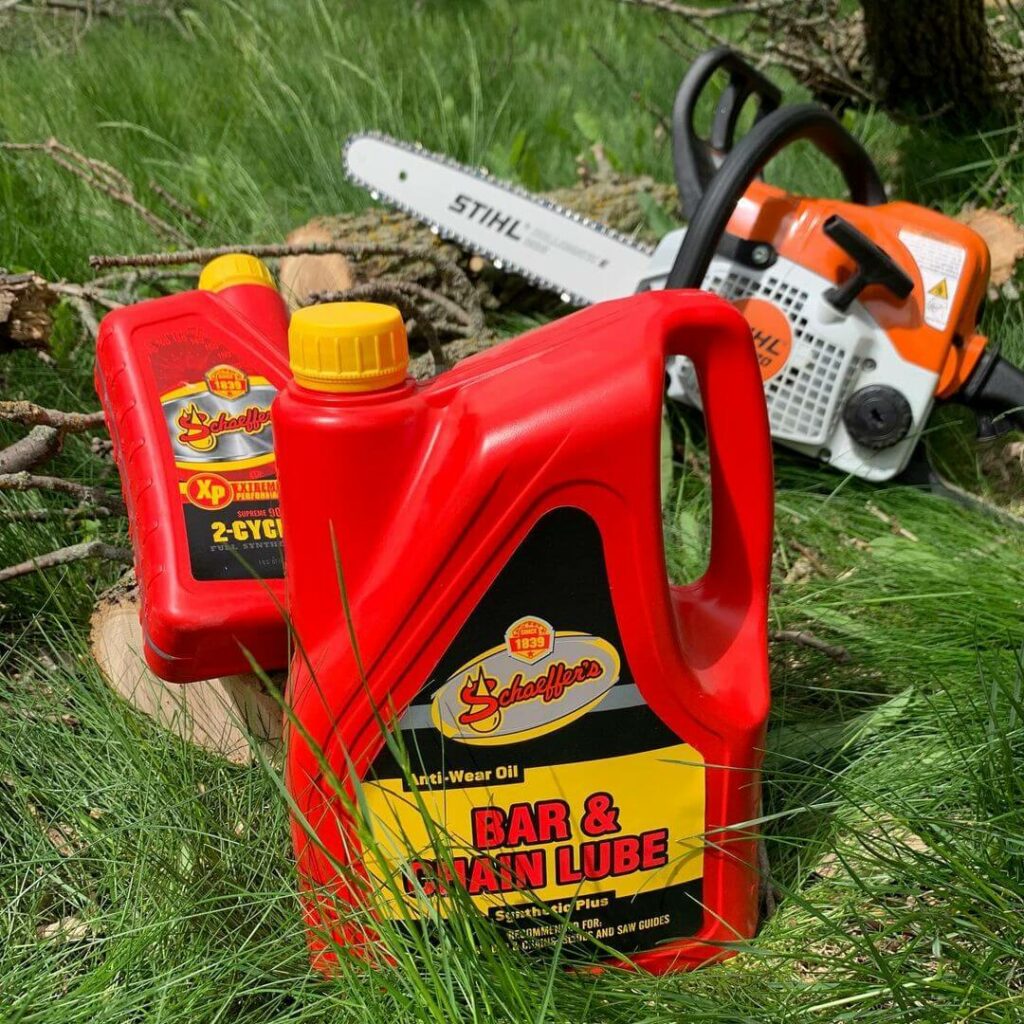How to Oil a Chainsaw Bar and Chain
Ever wondered why your chainsaw isn’t cutting as smoothly as it should? Proper oiling could be the key to transforming your cutting experience.
In a Nutshell:
Oiling a chainsaw bar and chain is crucial for optimal performance. Start by cleaning the chainsaw and locating the oil reservoir. Use a specialized chainsaw bar oil, filling the reservoir without overfilling. Distribute the oil by manually rotating the chain and applying oil directly to the bar’s tip and guide grooves. Check for proper oil flow with an oil fling test, ensuring even distribution. Regular oiling reduces friction, prevents wear, and extends the chainsaw’s lifespan, making it essential for maintenance.
Curious about the difference a well-oiled chainsaw can make? Dive into our comprehensive guide for in-depth tips and tricks to keep your chainsaw running smoothly and efficiently.
Understanding Chainsaw Lubrication
What is chainsaw bar oil?
Chainsaw bar oil is a specially formulated lubricant designed to reduce friction between the chainsaw’s chain and the guide bar. This oil is thicker than regular motor oil, ensuring it clings to the chain even at high speeds.
Its primary purpose is to keep the chain running smoothly, prevent premature wear, and extend the lifespan of the chainsaw. Regular use of chainsaw bar oil also helps in preventing your expensive Husqvarna or Echo chainsaw chain from getting stuck or jammed, ensuring efficient and safe operation.
What Oil Can Be Used for Chainsaw Bar Oil?
STP Premium Bar and Chain Oil: If you’ve ever used a chainsaw, you’ll know how crucial it is to have the right oil. I stumbled upon the STP Premium Bar and Chain Oil, and it’s genuinely impressive.
Designed specifically for chainsaws, it ensures the bar and chain glide smoothly, reducing wear and tear. With its stellar 4.7 out of 5-star rating from over 1,500 reviews, it’s clear that this oil delivers on its promise, making every chainsaw operation a breeze.
While the STP oil is specifically designed for chainsaws, there are times when one might need a substitute. Let’s delve into some of the other options that can be used as a chainsaw bar oil substitute.
Chainsaw Bar Oil Substitute Chart
| Type of Oil | Description |
|---|---|
| Standard Bar and Chain Oil | This is the most commonly used oil for chainsaws. It is specifically designed for this purpose and provides optimal lubrication. |
| Vegetable Oil | In some cases, especially for environmentally conscious users, vegetable oil can be used as a biodegradable alternative. However, it may not perform as well in colder temperatures. |
| Motor Oil | While not ideal, in emergencies, some users resort to using motor oil. It’s essential to ensure it’s of the right viscosity. |
| Canola Oil | Another biodegradable option, canola oil can be used, especially in warmer temperatures. |
| Used Cooking Oil | After being filtered, used cooking oil can serve as a makeshift chainsaw bar oil. However, it’s not the most efficient choice. |
Note: While there are multiple options available, it’s always best to use oils specifically designed for chainsaw bars to ensure optimal performance and longevity of the equipment. If using an alternative, ensure it’s suitable for the specific chainsaw model and the prevailing environmental conditions.
Difference between bar and chain oil and regular oil
While both bar and chain oil and regular motor oil serve the purpose of lubrication, they are formulated differently:
- Viscosity: Bar and chain oil is typically thicker than regular motor oil. This high viscosity ensures that the oil remains on the chain even when the chainsaw is operating at high speeds.
- Adhesive Additives: Chainsaw bar oil often contains adhesive additives that help the oil cling to the chain, ensuring continuous lubrication during operation.
- Temperature Resistance: Chainsaw bar oil is designed to maintain its consistency even under the high temperatures generated by the chainsaw’s rapid movement. In contrast, regular motor oil might thin out under such conditions.
Special characteristics of bar and chain oil
Bar and chain oil is uniquely designed for the rigorous demands of chainsaw operation. Some of its special characteristics include:
- Tackiness: This oil is tacky, ensuring it effectively sticks to the chain and doesn’t fling off during operation.
- Anti-wear Properties: It contains additives that protect the chain and bar from wear and tear, ensuring a longer lifespan for your chainsaw components.
- Rust and Corrosion Inhibitors: These additives protect the metal components of the chainsaw from rusting, especially when the chainsaw is stored for extended periods.
- Environmentally Friendly Options: Some modern bar and chain oils are biodegradable, making them environmentally friendly. These are especially useful when working in areas where environmental conservation is a priority.
Comparative Analysis: Bar and Chain Oil vs. Regular Motor Oil
| Feature/Property | Bar and Chain Oil | Regular Oil (Motor Oil) |
|---|---|---|
| Primary Use | Lubrication of chainsaw bar and chain | Engine lubrication |
| Viscosity | Typically thicker and stickier | Varies (e.g., 10W-40, 5W-30) |
| Additives | Additives to enhance stickiness and adherence | Additives for engine protection and performance |
| Temperature Resistance | Designed to withstand high friction temperatures | Designed to operate at engine temperatures |
| Environmental Impact | Can contain biodegradable components | May have environmental concerns if spilled |
| Cost | Can be more expensive due to specialized formulation | Generally cheaper |
| Adhesion | High adhesion to stay on bar and chain during operation | Lower adhesion compared to bar and chain oil |
Note: When choosing a bar and chain oil for my chainsaw, I’d say, ‘It’s not just about slickness, it’s about stickiness! The right viscosity, environmental impact, and temperature resistance are the trifecta for optimal chainsaw performance and longevity.
Signs Your Chainsaw Needs Oiling
How to determine if your chainsaw bar needs oil
Regardless of whether you’re wielding an Echo or Stihl chainsaw, determining if the bar needs oil is pivotal for its sustained performance and lifespan. The brand doesn’t change the essence of the check. Here are the telltale signs to be vigilant about:
- Excessive Heat: If the chainsaw bar becomes too hot to touch after a short period of use, it’s a clear sign that it’s not getting enough lubrication. A well-oiled bar should only be warm, not scalding hot.
- Smoke: If you notice smoke coming from the bar and chain area during operation, it’s an indication that the bar is not adequately lubricated. The friction between the chain and the bar due to lack of oil can cause this smoke.
- Squeaking Sound: An unusual squeaking or high-pitched noise during operation can indicate that the bar is dry and needs oiling.
- Visual Inspection: Regularly inspect the oil outlet holes on the bar. If they appear clogged or if there’s no visible oil on the bar’s surface, it’s time to oil.
Recognizing a dry chainsaw chain
A well-lubricated chain is essential for efficient and safe chainsaw operation. Here’s how to recognize a dry chainsaw chain:
- Rough Operation: If the chainsaw seems to be struggling, jerking, or not cutting smoothly, it might be due to a dry chain.
- Dull Appearance: A well-oiled chain will have a slight sheen due to the oil. If the chain looks dull or matte, it’s likely dry.
- Increased Fuel Consumption: A dry chain creates more friction, making the chainsaw work harder. This can lead to increased fuel consumption.
- Chain Stretch: Lack of lubrication can cause the chain to stretch prematurely. If you find yourself frequently adjusting the chain tension, it might be due to inadequate oiling.

Step-by-Step Guide to Oiling Your Chainsaw
Step 1: Preparing your workspace and gathering materials
A well-prepared workspace ensures safety and efficiency:
- Workspace: Opt for a flat, stable surface in a well-lit area. If working indoors, ensure the space is well-ventilated to dissipate any fumes. Spread a thick cloth or plastic sheet to catch any spills or drips.
- Materials: You’ll need chainsaw bar oil, a small funnel, a clean rag, a soft brush, a pair of gloves, and safety goggles.
- Safety Precautions: Disconnect the chainsaw from any power source. If it’s gas-powered, ensure it’s cooled down. Always wear gloves and safety goggles to prevent any accidental splashes.
Step 2: How to manually oil a chainsaw bar and chain
Manually oiling ensures that every part gets the lubrication and protection it needs:
- Clean the Chainsaw: Before oiling, use the soft brush to clean any debris or sawdust from the chainsaw, especially around the bar and chain.
- Access the Oil Reservoir: Locate the oil reservoir cap on your chainsaw, usually marked with an oil droplet icon, and unscrew it.
- Pour the Oil: Insert the funnel into the reservoir’s opening. Slowly pour the chainsaw bar oil, ensuring you don’t overfill. Fill up to the indicated mark or leave a small air gap.
- Distribute the Oil: After filling, manually rotate the chain a few times to help distribute the oil along the bar and chain.
Step 3: Where to apply bar oil on the chainsaw
Direct application ensures that the oil of product reaches critical areas:
- Tip of the Bar: The tip experiences the most friction. Tilt the oil bottle and apply a steady stream of oil along the edge of the bar’s tip while manually rotating the chain.
- Guide Grooves: These are the slots on the bar where the chain runs. Gently squeeze the oil bottle and run it along the grooves, ensuring the oil seeps in.
- Chain Links: As you rotate the chain, apply a drop of oil on the center of each chain link, ensuring it penetrates the moving parts.
Step 4: Ensuring proper distribution of oil
Even distribution is key to optimal performance:
- Run the Chainsaw: Safely start the chainsaw and let it idle for about a minute. This action helps circulate the oil throughout the bar and chain.
- Oil Fling Test: Hold a white piece of paper or cardboard about 20 inches away from the tip of the bar. Rev the chainsaw briefly. A fine spray of oil should appear on the paper, indicating the oil is flowing correctly.
Step 5: Pre-Start Safety and Fault-Finding Checks
Perform these pre-start checks before firing-up your chainsaw:
- Wear Appropriate Safety Gear: Before starting the chainsaw, ensure you have gloves, safety goggles, and protective clothing.
- Perform an Oil Flow Test: After oiling, conduct an oil fling test to confirm the oil’s proper flow.
- Check Chain Tension: Ensure the chain’s tension is neither too loose nor too tight, as it can impact oil distribution and the chainsaw’s performance.
- Inspect for Oil Leaks: Look for any signs of oil leakage, especially around the reservoir cap and the bar’s base.
- Avoid Overfilling the Reservoir: Overfilling can cause leaks and may reduce the chainsaw’s performance.
- Monitor Oil Dispensation: If your chainsaw doesn’t seem to be releasing oil, there could be a clog. Refer to your chainsaw’s manual for guidance on cleaning or replacing the oiler.
- Check Oil Level and Quality: Contaminants can degrade the oil over time, so frequent checks are essential.
- Store Chainsaw Oil Properly: Keep it in a cool, dry place and ensure the container is sealed tightly to preserve its quality.
Note: Proper chainsaw maintenance is a blend of preparation, precision, and safety. From a well-set workspace to ensuring even oil distribution, every step is pivotal for optimal performance and longevity.
Chainsaw Bar Oil Substitute
Can you use regular oil as a substitute?
Yes, in a pinch, regular motor oil can be used as a substitute for chainsaw bar oil. However, it’s essential to understand that while motor oil can provide the necessary lubrication, it’s not specifically designed for the high friction and unique requirements of a chainsaw bar and chain.
Chainsaw bar oil is typically stickier and has additives that help it adhere to the bar and chain, ensuring consistent lubrication during operation. If you decide to use motor oil, opt for a heavier weight like SAE 30 motor oil in warmer temperatures and a lighter weight like SAE 10 in colder climates.
The pros and cons of using alternatives like motor oil or WD40
Motor Oil:
- Pros:
- Availability: Motor oil is widely available and might be on hand when chainsaw bar oil isn’t.
- Cost-Effective: It’s generally cheaper than specialized chainsaw bar oil.
- Cons:
- Less Adhesive: Motor oil isn’t as sticky as chainsaw bar oil, so it might not adhere as well, leading to increased wear and tear.
- Environmental Concerns: Used motor oil can contain contaminants harmful to the environment.
WD40:
- Pros:
- Multipurpose: WD40 can be used for various tasks around the home, making it a versatile tool to have.
- Temporary Lubrication: It can provide short-term lubrication if you’re in a bind.
- Cons:
- Not Designed for Chainsaws: WD40 is a light lubricant and isn’t formulated to handle the demands of a chainsaw.
- Short-lived Lubrication: Its lubricating properties won’t last as long as dedicated chainsaw bar oil or even motor oil, requiring more frequent applications.
- Potential for Damage: Prolonged use can lead to increased friction and potential damage to the chainsaw’s bar and chain.

Common Queries and Misconceptions
The risk of over-oiling: Can you put too much bar and chain oil in a chainsaw?
Yes, it’s possible to over-oil a chainsaw, and doing so can lead to several issues:
- Wastage: Excess oil can spill out, leading to wastage and potential environmental concerns.
- Performance Issues: Over-oiling can cause the chainsaw to smoke or sputter during operation.
- Safety Hazards: Excess oil can make the chainsaw slippery, increasing the risk of accidents.
- Attracts Debris: Too much oil can attract sawdust and other debris, which can clog the chainsaw’s moving parts and reduce its efficiency.
It’s essential for customers to follow the manufacturer’s guidelines and regularly check the oil level to ensure optimal performance.
The difference between oil grades like 10w 40 and SAE 30 for chainsaw bar oil
Oil grades, such as 10w 40 and SAE 30, refer to the bar and chain oil’s viscosity, which is its resistance to flow:
- 10w 40: This is a multigrade oil. The “10w” indicates the oil’s viscosity at cold temperatures, while “40” denotes its viscosity at 100°C. It’s designed to perform well in both cold and hot conditions.
- SAE 30: This is a single-grade oil with a viscosity rating of 30. It’s best suited for warmer temperatures.
For chainsaw bar oil, stickiness and adherence are crucial. While both 10w 40 and SAE 30 can be used, it’s essential to consider the operating conditions. In colder climates, a multigrade oil like 10w 40 might be more suitable, while in warmer conditions, SAE 30 could be ideal.
Using the right oil for different chainsaw types, including electric chainsaws
Different chainsaws have varying requirements, and using the right oil mix is crucial for their longevity and performance:
- Gas-Powered Chainsaws: Both large and small gas chainsaws typically require a thicker, stickier oil that can withstand the high temperatures and friction generated during operation.
- Electric Chainsaws: Electric chainsaws tend to operate at lower temperatures than their gas-powered counterparts. As a result, they might require a lighter oil. However, it’s still essential to use a dedicated chainsaw bar oil to ensure proper lubrication.
Note: Regardless of the chainsaw type, always consult the manufacturer’s guidelines. Using the wrong oil can lead to increased wear and tear, reduced efficiency and speed, and potential damage.
In Conclusion
Regular oiling of your chainsaw isn’t just a routine task; it’s a pivotal step in ensuring the longevity and optimal performance of your tool. A diligently maintained chainsaw doesn’t just enhance efficiency for demanding tasks like chainsaw milling; it also amplifies safety during operation.
Key Takeaways:
So, as you wrap up your woodworking tasks and store away your chainsaw, remember that a little attention to its maintenance can go a long way. Here’s to many more great years of seamless cutting and optimal chainsaw performance!



